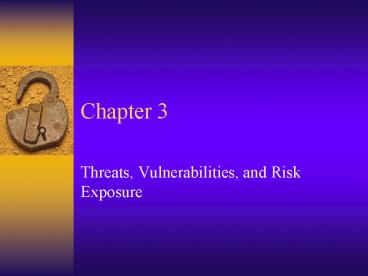Threats, Vulnerabilities, and Risk Exposure - PowerPoint PPT Presentation
1 / 13
Title:
Threats, Vulnerabilities, and Risk Exposure
Description:
... infected pgm (malware) in an e-mail to an employee (internal intermediary) who ... Malware Viruses, Worms, Trojan Horses, Backdoors, Web Hoaxes, and other ruses ... – PowerPoint PPT presentation
Number of Views:558
Avg rating:3.0/5.0
Title: Threats, Vulnerabilities, and Risk Exposure
1
Chapter 3
- Threats, Vulnerabilities, and Risk Exposure
2
Introduction
- In Security planning an organization must first
know what it needs to protect against - Companies must be aware of type and severity of
threats and vulnerabilities - Vulnerability Exposure to a risk or threat see
def on pg. 209 - Could be a weakness in HW, SW, or people
- Could be IP protocol exposing a computer or user
to an exploit or malware threat - What is an exploit?
- Look at Cyberbrief on pg. 34 (top)
3
Classification of Computer Threats and
Vulnerabilities
- The taxonomy of threats and viruses is
abbreviated (TTV) - Intrusion any type of intrusion, attack, or
exploit - Vulnerabilities exist b/c of human error
- Vulnerabilities exist b/c of complexity of sw
that can result in misconfiguration, programming
errors, flaws - Most intrusions will fit into multiple categories
- Hacker (external intruder) can send infected pgm
(malware) in an e-mail to an employee (internal
intermediary) who opens it b/c of enticing
subject line (social engineering) which installs
a backdoor (malware) to gain access to records
(deliberate attack) for financial gain (economic
motive)
4
Uses of TTV
- The TTV is a guide to help understand an
organizations risk exposure resulting from
weaknesses in cyber defenses - Can assist in estimating expected damages
- Intrusion Detection Systems introduced when
properly deployed can provide warnings indicating
that system is under attack - Can look at all traffic in and out of network
with IDS to stop internal and external intrusions - An intrusion not detected and which persist for a
long period of time can have higher expected cost
that those detected early
5
TTV (2)
- Direct attacks or targeted attacks will also have
higher expected costs - B/C there is such a diverse range of threats the
design of defenses should include education,
training, strict acceptable use policies,
extensive auditing, and access controls - Look at the TTV chart on pg. 35
- How would you use it to assess a virus attack on
campus? - Look too at the end of the TTV on pg. 36?
- What can you think to do with this TTV if you
work in an organization? - Look at cyberbrief bottom pg. 36
6
Origin of the Intrusion or Threat
- External Threats and Vulnerabilities
- You should read this section closely all terms
may be on test - Weve already discussed much of this section
- Hackers, buffer overflow
- Sophisticated Hackers, root access, sniffers, log
file cleaners - Script Kiddies
- Malware Viruses, Worms, Trojan Horses,
Backdoors, Web Hoaxes, and other ruses - Internal threats and vulnerabilities
- People, Current and former managers and ex
employees - Look at numbers in this section on pg. 41
7
Problems in Dealing w/ Internal Threats
- Problems in dealing w/ internal threats (read
parts of this paragraph) - Internal Threats stemming from employees or other
insiders - Read through this list
- Class, provide an example (or two) of each of
these from what you know of or have heard in real
life - The list continues onto pg. 43
- Briefly look at Insider threats on pg. 43
8
Wireless Threats and Vulnerabilities
- Pg. 44 read last two paragraphs (especially)
9
External Threats with Internal Intervention
- Social Engineering
- A network intrusion technique based on trickery
- Look at 2nd paragraph
10
Internet Protocol Vulnerabilities and Threats
- IP address forgery
- The IP provides for two functions
- A datagram that can be routed through the
Internet, and provides a means for fragmenting
those datagrams into packets for transport across
the Internet and then reassemble them into the
original datagrams at the destination computer - Look at last paragraph of pg. 45
11
How can IP Address Forgery Be Used
- A method of deception
- To Conceal - identity
- To Camouflage make a site appear to be another
to convince victim attack is from a legitimate
site - To Deceive trick victim into believing that an
intrusion is somewhere else - Misdirect victimized organization into wasting
limited resources
12
Success of Hackers and Malware
- Read Complexity of Software and Configurations
- Review bulleted list on Why Hack Attacks Succeed
so often pg. 47
13
Threats, Vulnerabilities, and First-Party and
Third-Party Risks
- First-party risks are those that concern the
company itself - Third-party risks are threats to the companys
customers, suppliers, business partners or
competitors that may seek legal redress by
lawsuit - You can review the lists of First-Party Risks and
the list Third-Party Risks we have discussed most
of this already this semester - End of Chapter
- Look at Review Questions
- All of them are excellent!!

